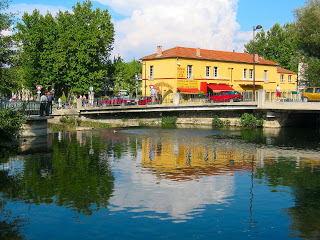
This post is the third in a series that will feature each of the ten markets that The Modern Trobadors always visit when in Provence. The markets were selected primarily on the basis of the quality of the offerings of the vendors and the ambiance of the venue although practicality was also considered to some extent (e.g., distance from our home in Lourmarin, market options on that day of the week, convenience of parking, etc.). Bottom line is that these are the markets we visit when we are in Provence. Again and again…and again.
The Sunday Market at L’Isle-sur-la-Sorgue is a cornucopia of the usual fruits, vegetables, meats, cheeses, specialty foods, flowers, linens, ceramics, clothing, jewelry, gadgets galore and, ahhh, so much more.
The Sunday Market at L’Isle-sur-la-Sorgue is a cornucopia of the usual fruits, vegetables, meats, cheeses, specialty foods, flowers, linens, ceramics, clothing, jewelry, gadgets galore and, ahhh, so much more.
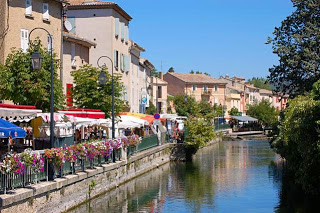 |
| Photo: David Scott Allen |
As George McQuilken, a regular traveler for over twenty years to L’Isle-sur-la-Sorgue, puts it: “Everything in the world is sold there!”
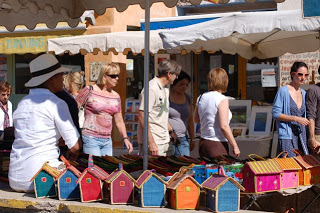 |
| Photo: David Scott Allen |
In addition to the typical Provençal market, there is a well-established outdoor flea market (brocante) on Market Day (and Saturdays) and a world-renown antiques market permanently housed in neighboring buildings. There are engaging musicians—some so captivating that you will find yourself setting down your laden basket to listen—scattered throughout the huge market during the summer months. And the setting—an island in the Sorgue River…need I say more?—is lovely.
L’Isle-sur-la-Sorgue is located mid-way between Cavaillon and Carpentras on D938 and west of Fontaine-de-Vaucluse, a popular tourist destination (er, trap, in my mind) where the River Sorgue begins—from a spring that mysteriously spews forth from a hole in the side of a cliff—the source of which not even Jacques Cousteau could establish and still remains unknown.
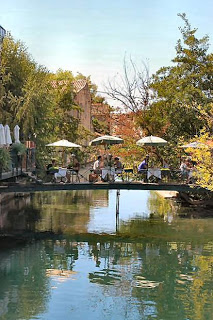 |
| Photo: David Scott Allen |
From Lourmarin, where our apartment La Bonbonnière is located, we usually drive to L’Isle-sur-la-Sorgue on Route d’Apt (N100). (It’s about a 40-km or 50-minute drive.) Once in the town, we veer to the right at the traffic circle onto Cours Fernande Peyre, a plane-tree lined avenue, where we park.*
The Sunday brocante and antiques market are hugely popular and draw serious buyers from around the world. It is a regular—probably requisite—destination for designers and dealers from…
Paris and London who come down for the weekend, armed with long lists of items to buy for their clients and stores. Major container and shipping companies all have offices and a thriving business in L’Isle-sur-la-Sorgue.
Paris and London who come down for the weekend, armed with long lists of items to buy for their clients and stores. Major container and shipping companies all have offices and a thriving business in L’Isle-sur-la-Sorgue.
In other words, it gets crowded, especially in the summer months: Don’t drop anything because you may not be able to bend down to retrieve it and hang on to the kids! Actually, my best advice is to go to Market with tall people who wear hats: We never lost sight of David Scott Allen who, with his partner Mark Sammons, visited us in 2008, probably because he donned a hat atop his 6’2” frame and, come to think of it, years earlier, we never lost sight of our family friend Dustin Blaylock, 19-years-old, 6’1’’ who had just—inadvertently—dyed his dark hair blonde!
Get there early to find parking and plan to cap off the long morning at the market with a leisurely lunch and stroll around the town after the crowds have dissipated.
While the flea market and antique businesses grab the attention of magazines, newspapers, and tour books, I would be remiss if I didn’t emphasize the wonderful appeal of the more traditional side of L’Isle-sur-la-Sorgue Market. Because we always park near the entrance to that side of the market (at the Porte de Bouigas), our typical routine is to begin our visit to the Market there.
Salmon and ham, bakery goods, scarves, espadrilles, linens, and pottery—in that order—are what I focus on at L’Isle-sur-la-Sorgue Market. Unless I take along a cooler and plan to go straight back to Lourmarin, I stay away from the perishable fruits and vegetables. (I purchase those at the Friday Lourmarin Market, the Monday Cadenet Market, or the Tuesday Cucuron Market.)
If I could only make one stop in the Market, it would be to buy the most heavenly salmon I’ve ever seen—expertly handled and artfully sliced as if the proprietor were Michelangelo sculpting his block of Carrara marble—and as tasty as I have ever had. (So flavorful, it needs minimal adornment: on our 2008 vacation, I recall that David roasted our salmon with just piment espelette, salt, and pepper and served it with lightly fried zucchini blossoms, and one of Mark’s favorite salads of fennel, carrot, and prosciutto.)
The same vendor also has wonderful ham—“incredibly succulent and not-at-all salty” as David said—which we also buy. The jovial vendor will gladly pack your purchases in ice, too, if you are traveling far. His operation is located on place Ferdinand Buisson (where you will also find a wonderful patisserie called Montéro André, a stop we often make for dessert).
Scarves. I always fall in love with at least one scarf at this market and they are rarely very expensive. One of the scarf vendors I like best is on the Quai Jean Jaures, on the right, about ten stalls in from the entrance at the Porte de Bouigas. The best espadrilles—at the best price—are also found at this market. Linens—table cloths, place mats, napkins, runners, bed spreads, pillow covers—are all available in abundance in this city, where the giant water wheels powered a thriving textile industry in the middle ages. (Make sure and stop to see these wheels—nice photo op.) Finally, pottery may be found in many stalls through out the market—I usually can’t resist the purchase of some tiny piece!
By the time we have made our way through the market’s winding streets to find the aforementioned items (and before we head over to the flea market and antique shops), we usually find ourselves in the midst the colorful flower vendors in the bustling Place de la Liberté. Our favorite Café de France beckons us on one side and the extraordinary Collégiale of Nôtre-Dame-des-Anges stands sentinel on the other.
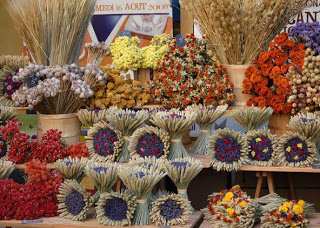 |
| Photo: David Scott Allen |
Until summer of 2008, we had never ventured into this rather plain looking church with the ornately decorated Baroque interior. Mark, our dear friend and a true Renaissance man, said it was a “must see” and he has a way of turning even the most ordinary site into something fascinating. So, after many years of walking past this seemingly unremarkable church, we went inside. Quel experience!
It is a very small church teeming with so many statues, wood carvings, frescoes, and paintings—all gilded, glorious, and undoubtedly virtuous—that feelings of claustrophobia might emerge in those susceptible to such anxieties.
Mark, being much more knowledgeable about churches and the like than I, describes his experience quite differently and far more eloquently:
[The church was] architecturally fascinating enough that my attention was (gasp!) drawn away from the extensive farmers’ market.
[T]he back of [the church] caught my eye for its apparently Gothic apse and earlier Romanesque tower, and perhaps Romanesque nave.
When I went inside, I was not merely fascinated by the Baroque ornament laid over the underlying structure, a common enough feature in European churches everywhere (perhaps most especially in Rome); I was stunned by the unexpected richness of it, especially in so small a town. And then further surprised upon exiting the front door and turning around to see the austerely elegant facade (perhaps a generation later than the interior decor?).
Did 17th and 18th century textile dying pay for this lavish redecoration? Was there noble patronage? Perhaps a powerful cardinal associated with the church? What was going on there between, say 1650 and 1780 to make this possible? It makes me wish I knew more about French architectural history.
Now that we’ve piqued your curiosity, do take a break from the Market to step inside this very interesting church. It will provide fodder for conversation over at Café de France, opposite the church.
Whether it is time for a café crème, an espresso, or a glass of rosé, grab a table (if you can) at this turn-of-the-century cafe. Inside, the art nouveau setting of large mirrors and wood paneling looks a place van Gogh and Gaugin, who lived in nearby Arles, would have frequented. Outside, the people-watching is superb. The food—simple fare—is excellent. I recommend their salade chêvre—the chef added a little caviar de aubergine and miel to the baguette toasts before melting the chêvre (a combination we have reproduced many times at home!).
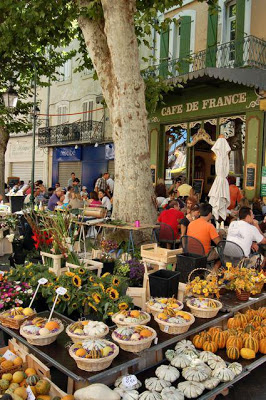 |
| Photo: David Scott Allen |
Le Caveau de la Tour d L’isle is another good stop. It is a wine bar and wine shop.
Alternatively, grab a slice of pizza from one of the pizza trucks with wood-fired grills and head over to the other part of the market.
The flea market is located on Avenue des Quatre Otages. There you will find collectibles and other interesting bric-a-brac not quite old enough to be antique. Our favorite purchases are our brass candlesticks, wrought iron wine bottle carriers, and a set of six 2000 World Cup Soccer glasses.
If your wallet is still full, cross the street to the row of antique stores or to Le Village des Antiquaires, a veritable shopping mall of antiques. Most items are not priced and all are negotiable.
We have never found just the right item (that our wallets would accommodate), but such constraints never stop us from looking. I am still yearning for a set of silverware.
Peter and Maureen Bristol, from South Africa, found an interesting piece for their Luberon home: an open dresser with a marble top. The two drawers at the top are “heavily carved and [have] handles [that] are ‘carved angry pussycats with big ears.’” “Donc!” they go on to explain, “for ever more, it is the angry pussycat!”
A nice way to cap off the afternoon is to enjoy a leisurely lunch. We have thoroughly enjoyed Mas De Cure Bourse, on the outskirts of town, where one may dine on their oak-shaded terrace in the summer or, in the chilly months, in the dining room near the fireplace. Outstanding food, professionally served in a very relaxing atmosphere.
Lis Steeden, reports that she and husband Graham really enjoy Le Petit Jardin for a simple lunch after the market.
Lee-Ann McQuilken and husband George have several recommendations for meals. They have joined family and friends for vacation in this town for many years, enjoying not only the Market, but the restaurants, kayaking and canoeing, and the simple commarderie of friends and family in such a relaxing environment. They stay in Domaine de la Fontaine, which is owned by a German husband and French wife who moved from Germany to raise their children in Provence. German friends of George, knew the couple from Munich, suggested that they meet in their Inn about 20 years ago, and they’ve all been going ever since.
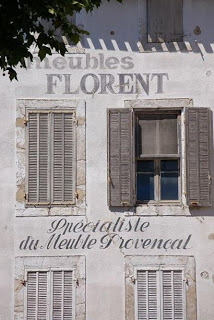 |
| Photo: David Scott Allen |
Their top recommendations for exquisite (not inexpensive) dining are: La Prévoté, where a branch of the Sorgue can be seen flowing beneath the restaurant; Le Vivier de la Sorgue, where there is a lovely view of the river from the terrace; and L’Ousteau de L’Isle, where there is a beautiful view of their garden from the terrace.
L’Isle-sur-la-Sorgue Market is a wonderful place to while away a Sunday in Provence. I suspect you may find yourself coming back again and again for the Market or another meal! I hope to be back soon for the silver!
* Lis Steeden, Danish friend from England who often visits Provence with husband Graham to stay in their Mallemort home, recently told me that many of the old plane trees in L’Isle-sur-la-Sorgue had been cut down due to disease. I am not certain if this sad news pertains to this avenue of plane-trees.
For a list of other The Modern Trobadors (TMT) posts about markets in Provence, click here.
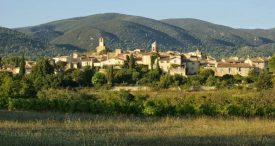
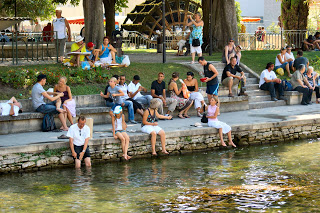

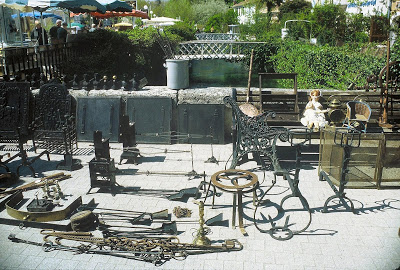

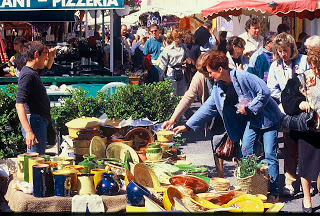
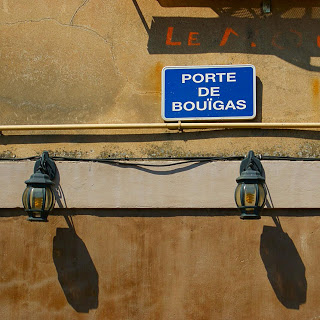
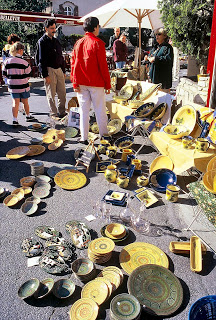





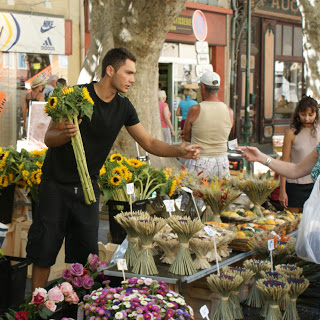

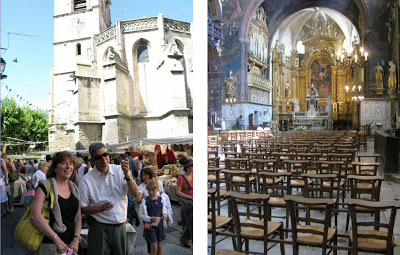
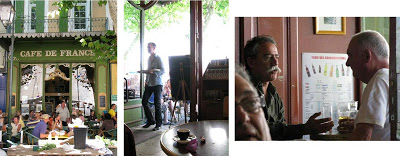

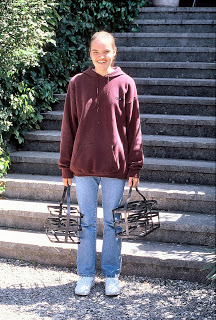
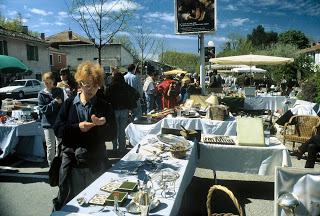
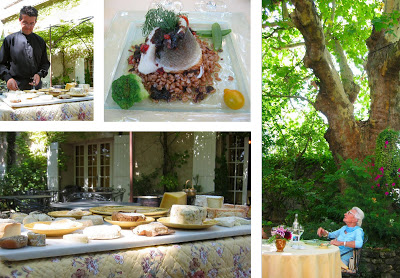
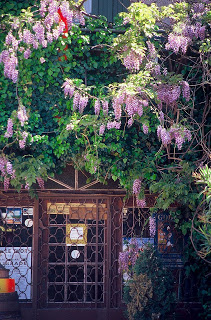
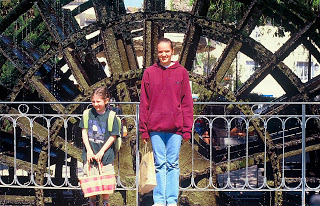





Great article and wonderful photos! Merci!
Oh, to have a slice of that ham right now! Thanks again for a great post! I am going to spend some time today looking at all my photos of Ile-sur-la-Sorgue! I particularly loved how this market meanders through the streets of town – not just in one central area. David
I agree, your article this week was fabulous. We need more time in Provence!!! Merci from Kathy in Angels Camp Ca.
Wonderful to revisit Ile-sur-la-Sorgue with David's great photos and to also spend time on the Cocoa and Lavender site. Can't wait to try some of the recipes or to returen to Provence.
Monte Dolack
Every time I visit Provence I go to this market, the pictures here bring back some wonderful memories of this beautiful town, absolutely magical.
Paul Bragg
Wow